1169∕08—2007 光伏电缆标准
光伏电缆介绍

太阳能光伏直流输送电缆的选型在太阳能光伏发电系统中低压直流输送部分使用的电缆,因为使用环境和技术要求不同,对不同部件的连接有不同的要求,总体要考虑的因素有:电缆的绝缘性能、耐热阻燃性能、搞老化性能及线径规格等。
具体要求如下。
1、太阳能电池组件与组件之间的连接电缆,一般使用组件接线盒附带的连接电缆直接连接,长度不够时还可以使用专用延长电缆。
依据组件功率大小的不同,该类连接电缆有截面积为2.5m㎡、4.0m㎡、6.0m㎡等三种规格。
这类连接电缆使用双层绝缘外皮,具有优越的防紫外线、水、臭氧、酸、盐的侵蚀能力,优越的全天候能力和耐磨损能力。
2、蓄电池与逆变器之间的连接电缆,要求使用通过UL测试的多股软线,尽量就近连接。
选择短而粗的电缆可使系统减小损耗,提高效率,增强可靠性。
3、电池方阵与控制器或直流接线箱之间的连接电缆,也要求使用通过UL测试的多股软线,截面积规格根据方阵输出最大电流而定。
名部位直流电缆截面积依据下列原则确定:太阳能电池组件与组件之间的连接电缆、蓄电池与蓄电池之间的连接电缆、交流负载的连接电缆,一般选取的电缆额定电流为各电缆中最大连续工作电流的1.25倍;太阳能电池方阵与方阵之间的连接电缆、蓄电池(组)与逆变器之间的连接电缆,一般选取的电缆额定电流为各电缆中最大连续工作电流的1.5倍。
PV-电缆(光伏组件用电缆)1、技术规范PV-电缆(光伏组件用电缆)目前尚无国家或行业标准,本试验技术规范所涉及到的要求来自于德国标准化委员会PV-系统用电线K411.2.3工作组的初稿。
这个初稿将作为德国国家标准报批稿进行发布。
德国莱茵TUV(上海)将用此技术规范对PV-电缆的性能进行检测和评估。
在德国莱茵TUV公司内部此技术规范的文件编号为2PfG 1169/08.2007。
2、使用范围2PfG 1169/08.2007适用于最高允许1.8kV(线芯对线芯,非接地系统)直流电压、在光伏系统中CD侧使用的单芯软电缆(电线)。
PV1_F型双芯可分离光伏电缆的研制_张红艳
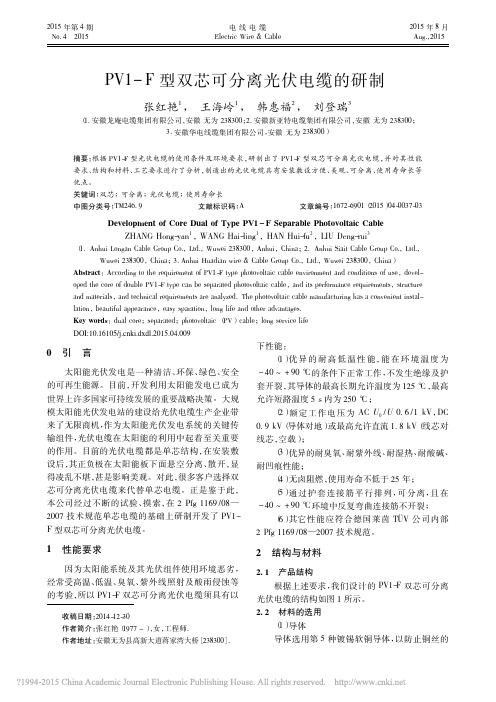
氧化, 其结构及性能指标符合 GB / T 3956 —2008 标 准的规定。 ( 2 ) 绝缘 绝缘采用 125 ℃ 光伏电缆专用辐照交联聚烯烃 绝缘料, 平行的两芯电缆绝缘采用红和蓝两色进行 区分。此绝缘料须具有耐高温 125 ℃ 、 低温 - 40 ℃ 性能, 以满足电缆苛刻的环境使用温度 , 并且绝缘还 应具有耐酸碱性能和优异的电气绝缘性能, 更重要 的是绝缘必须具有优异的抗氧化性能 , 以达到 25 年 的使用寿命。 ( 3 ) 隔离剂 在挤包护套时, 为了避免护套和绝缘粘连, 在绝 。 缘表面必须涂覆一层隔离剂进行隔离 为了环保, 不让隔离剂对电缆造成污染, 选用 1250 目环保型滑 石粉进行涂覆隔离。 ( 4 ) 护套 由于电缆是长期暴露在室外恶劣环境中, 其护 、 、 、 套必须具有耐高低温交替变化 耐湿热 阻燃 耐老 化、 耐臭氧、 耐紫外线照射、 耐酸雨及碱性物质的侵 蚀、 耐磨等性能, 才能满足电缆 25 年的使用寿命要 求。鉴于此, 护套料应选用 125 ℃ 光伏电缆专用辐 照交联聚烯烃护套料。
伏接线盒接线端子的尺寸 。 ( 5 ) 护套连接筋 PV1F 型双芯可分离光伏电缆护套连接筋的设 计及挤出非常关键, 连接筋的尺寸直接关系到双芯 电缆的外观和分离性能。 如果连接筋过宽, 会加大 双芯光伏电缆的宽度, 给安装敷设造成不便; 连接筋 厚度过大, 两芯安装时难以分离, 如果用较大力气分 离, 有时会把护套撕裂而连接筋却完好无缺 , 所以连 接筋的结构尺寸要求非常关键。我们经过多次试制 及试验得出, 两 芯 之 间 连 接 筋 的 宽 度 以 0. 7 ~ 0. 8 mm 为宜, 厚度以两边厚中间薄, 即两边厚度与护套 , 厚度相当 中间厚度为护套厚度的二分之一弧状结 构为好。这样的结构既好分离, 又不损伤护套, 并且 此双芯光伏电缆在 - 40 ~ + 90 ℃ 环境中以短轴方 向反复弯曲连接筋也不会开裂。 ( 6 ) 辐照交联 由于光伏电缆的动态穿透试验和热寿命试验均 对电缆的要求较高, 但两者指标相互矛盾, 故生产时 对其必须加以平衡。 如果电缆交联度较高, 虽然电 缆很容易通过动态穿透试验, 但很难通过 5000 h 的 热寿命试验, 因此根据生产经验, 绝缘及护套挤出后 印字并一次性辐照交联, 其绝缘的载荷下伸长率应 控制 在 40% ~ 50% , 护 套 应 控 制 在 30% ~ 40% [1 ] 为宜 。
光伏电缆特性介绍
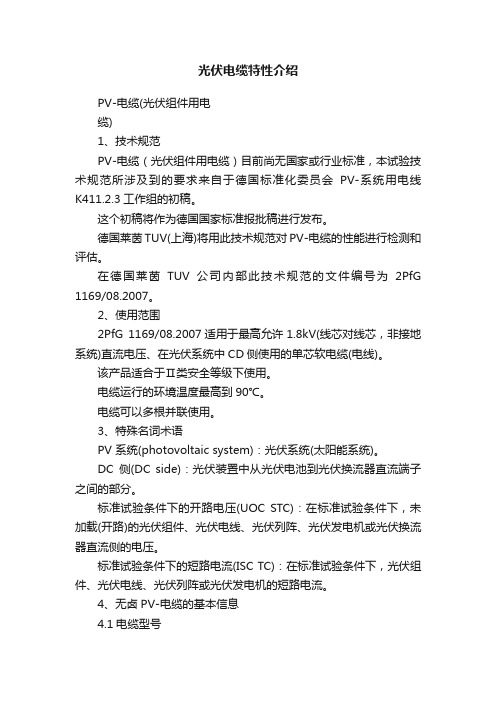
光伏电缆特性介绍PV-电缆(光伏组件用电缆)1、技术规范PV-电缆(光伏组件用电缆)目前尚无国家或行业标准,本试验技术规范所涉及到的要求来自于德国标准化委员会PV-系统用电线K411.2.3工作组的初稿。
这个初稿将作为德国国家标准报批稿进行发布。
德国莱茵TUV(上海)将用此技术规范对PV-电缆的性能进行检测和评估。
在德国莱茵TUV公司内部此技术规范的文件编号为2PfG 1169/08.2007。
2、使用范围2PfG 1169/08.2007适用于最高允许1.8kV(线芯对线芯,非接地系统)直流电压、在光伏系统中CD侧使用的单芯软电缆(电线)。
该产品适合于Ⅱ类安全等级下使用。
电缆运行的环境温度最高到90℃。
电缆可以多根并联使用。
3、特殊名词术语PV 系统(photovoltaic system):光伏系统(太阳能系统)。
DC侧(DC side):光伏装置中从光伏电池到光伏换流器直流端子之间的部分。
标准试验条件下的开路电压(UOC STC):在标准试验条件下,未加载(开路)的光伏组件、光伏电线、光伏列阵、光伏发电机或光伏换流器直流侧的电压。
标准试验条件下的短路电流(ISC TC):在标准试验条件下,光伏组件、光伏电线、光伏列阵或光伏发电机的短路电流。
4、无卤PV-电缆的基本信息4.1电缆型号PV1-F4.2电缆特性●额定电压:AC U0/U=0.6/1kVDC 1.8kV(线芯对线芯,非接地系统,没有负载下的回路)如果电缆使用在直流系统中,其导体间的额定电压应不大于电缆AC额定值U的1.5倍。
在单相接地直流系统中,此数值应乘以0.5的系数。
●温度范围:环境温度: -40℃到+90℃导体最高工作温度:120℃电缆运行的环境温度最高到90℃。
依据EN60216-1标准进行考核,其绝缘和护套的温度指数是120℃。
期望使用寿命是25年5秒钟的短路温度是200℃4.3电缆结构●导体导体芯数: 1导体是EN60228(IEC60228、GB/T3956)中的第5类导体,而且必须是镀锡的。
光伏电缆技术规范书

`Word文档50MW领跑者光伏发电项目光伏专用电缆技术规书目录附件1 技术规 (1)附件2 供货围 (8)附件3 技术资料和交付进度 (9)附件4 交货进度 (10)附件5 检验和性能验收试验 (11)附件6 包装及运输 (14)附件7 技术服务 (16)附件8 分包与外购 (18)附件9 大(部)件情况 (19)附件10 技术差异表 (20)附件1 技术规1. 工作围1.1 投标人供应的电缆应是全新的、技术先进的并且符合技术规和工业标准的优质电缆。
1.2 投标人应根据需要派遣技术熟练、合格的工程技术人员到工地进行技术服务。
详细技术服务在本标书第7条款“投标人的现场技术服务”中规定。
1.3 对于安装施工后电缆的退货要求,按招标文件商务条款执行。
1.4 电缆的包装(包括电缆盘)和运杂费均包含在合同单价。
1.5 投标人提供给招标人需要的技术文件及资料,价格包含在合同单价。
1.6 投标人按照招标人提供的电缆定尺定盘数据供应特种电缆,做好电缆定尺定盘工作。
在电缆盘两侧均按招标人提供的清单打印盘号和电缆编号,并配专用铭牌。
2.技术规2.1 总则2.1.1 本技术规书适用于光伏专用电缆的功能设计、结构、安装和试验等方面的技术要求。
2.1.2 本技术规书提出的是最低限度的技术要求,并未对一切技术细节作出规定,也未充分引述有关标准和规的条文,投标人应提供符合本技术规和工业标准的优质产品。
2.1.3 如果投标人没有以书面形式对本规书的条文提出异议,则意味着投标人提供的电缆完全符合本规书的要求。
如有异议,不管是多么微小,都应在报价书中以“技术差异表”为标题的专门章节中加以详细描述。
2.1.4 本技术规书使用的标准如遇与投标人所执行的标准不一致时,按较高标准执行。
2.1.5 本技术规书经招、投标双方确认后作为订货合同的技术附件,与合同正文具有同等法律效力。
2.1.6 本技术规书未尽事宜,由招、投标双方协商确定。
2.2技术要求2.2.1 应遵循的主要现行标准(如果有最新版,按最新的标准执行,不限于以下标准):GB 12706 额定电压35kV及以下铜芯铝芯塑料绝缘电力电缆GB 2952 电缆外护套GB/T 3956 电缆的导体GB 12666 电线电缆燃烧试验方法GB 2951 电线电缆机械物理性能试验方法GB 6995 电线电缆识别标准GB 50217 电力工程电缆设计规GB 3953 电工圆铜线GB 3957 电力电缆铜、铝导电线芯GB 4005 电线电缆交货盘的技术要求GB 8170 数值修约规则GB 50150 电气装置安装工程电气设备交接试验标准TICW8-2012 额定电压6kV(Um=7.2kV)到35kV(Um=40.5)挤包绝缘耐火电力电缆JB/T8137 电线电缆交货盘GB 9330 塑料绝缘控制电缆2.2.2 导体采用EN60228(IEC60228)标准规定的镀锡铜丝绞合第5种导体(软导体)。
(低烟无卤聚烯烃类)光伏电缆料的配方和技术讨论

光伏电缆料目前有两个行业标准:
1.欧规:符合TüV光伏电缆标准2 Pfg 1169/08.2007
2.美规:符合UL854-2007 还有UL4703
另外一些材料生产商还会生产符合UL和TüV这两个认证的双认证光伏电缆料。
两个标准的难点:
TüV 2 Pfg 1169/08.2007 这个标准里面会有一个关于长期使用热寿命的要求光伏电缆是 25年利用阿累尼乌斯方程进行推导来计算90℃条件下原始断裂伸长率下降到50%的时候是的时间(需要≥25年)。
UL标准的光伏料一个是阻燃要VW-1,还有一个电线浸水14天的电容率的比值好像是原始的电容率跟 7天还有14天的电容率进行计算比值不能超过一定的范围之内这两个难点。
不知道论坛里面有没有人在这方面有了解的可以分享给大家伙。
双认证的料肯定是要通过两个要求指标。
光伏电缆标准-译文
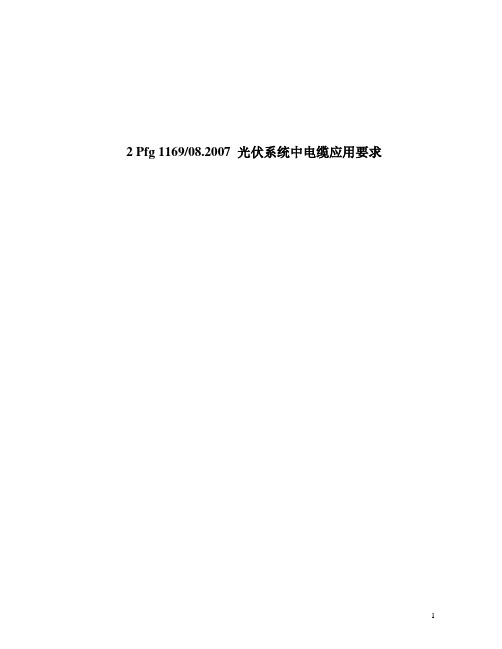
2 Pfg 1169/08.2007 光伏系统中电缆应用要求目录页码前言 (3)1 范围 (3)2 规范性附录 (3)3 术语和定义 (5)4 无卤素光伏电缆 (6)4.1 规定牌号 (6)4.2 特征 (6)4.3 结构 (6)4.4 试验 (8)4.5 使用指南(参考) (8)4.6 载流能力 (8)附录 A (规范性附录)影响试验 (15)附录 B (规范性附录)无卤素试验 (16)附录 C (规范性附录)卤素的测定–元素试验 (17)附录 D (规范性附录).长期耐绝缘DC的试验方法 (19)附录 E (规范性附录)冷冲击试验 (20)附录 F (规范性附录) 动力触探试验 (21)附录 G (规范性附录) 凹槽扩散 (23)图1 –标记的安排 (8)图F.1 –穿透试验的安排 (22)表1 –光伏电缆的载流能力 (9)表2 – (9)表3 –无 (10)表4 - (13)表A.1 –要求 (15)表B.1 –试验方法、测量、要求 (16)表 B.2 –试验顺序 (16)表 E.1 –冷冲击试验的参数 (20)前言本试验规范的内容在一个工作组稿件支AK列出的要求411.2.3“Leitungen献给光伏系统有限公司”的德国标准化委员会(DKE)。
此手稿是拟作为德国前标准公布。
截至会前,这个测试标准,德国TUV莱茵规范的出版日期将被用于测试和评估中的电缆光伏系统(光伏电缆)的使用。
1.范围2 PfG 1169/08.2007适用于光伏系统直流侧使用的单芯软电缆(软线),其最大可允许电压为1.8千伏直流(导体-导体,不接地系统)。
电缆适合用于安全等级II的情况。
允许以多结构的方式,将这些电缆连接起来。
该电缆的设计目的是用于在室温下操作,最高温度可达90℃。
2.规范性文献以下引用的文件是使用本文件必不可少的部分。
凡是注日期的引用文献,只有被引用的版本才适用。
凡是不注日期的引用,该引用的文件(包括任何修订)的最新版本应适用。
光伏电缆技术知识三十问

光伏电缆技术知识三十问关于标准:1、光伏电缆的执行标准有哪些?光伏电缆目前尚无国家标准,多芯光伏电缆国内常用标准为:美国安全检测实验室公司UL标准:UL 1277-2001 有可选光纤值的电力电缆和控制底座电缆;德国莱茵TUV集团标准:2Pfg1940/12.2011。
单芯光伏电缆国内常用的标准为:美国安全检测实验室公司UL标准:UL 4703-2014光伏线调查大纲;德国莱茵TUV集团标准:2Pfg 1169/08.2007 光伏系统中使用的电缆要求;中国电器工业协会系列标准:CEEIA B218-2012 光伏发电系统用系列标准。
2、美国UL 4703标准规定的电缆额定电压等级有哪些?UL 4703标准规定的电缆额定电压为:600V、1000V或2000V。
3、美国UL 4703标准规定的电缆温度等级有哪些?干:90℃,105℃,125℃,150℃;湿:90℃。
4、美国UL 4703标准中电缆导体可以采用哪些材料?导体材料可以采用铜(可镀锡、镀镍或镀银),AA8000系列铝合金或者铜包铝。
5、美国UL 4703标准中电缆绝缘可以采用哪些材料?绝缘可以采用:XL、EP、EPCV、CP、CPE。
6、德国TUV 2Pfg 1169/08.2007标准规定的导体结构及材料?导体是EN60228(IEC60228、GB/T3956)中的第5类导体,而且必须是镀锡的。
7、德国TUV 2Pfg 1169/08.2007标准规定的温度范围?环境温度:-40℃到+90℃;导体最高工作温度:120℃;电缆运行的环境温度最高到90℃,依据EN60216-1标准进行考核,其绝缘和护套的温度指数是120℃。
5秒钟的短路温度是200℃。
8、光伏电缆国内有相关的执行标准吗?国内有执行标准,«光伏发电系统用电缆»系列标准由上海金友金弘电线电缆有限公司、北京鉴衡认证中心等单位起草,由中国电线电缆标委会归口,于二O一二年四月十八日正式发布。
光伏电缆标准pfg1169解析

标题:探析光伏电缆标准PFG1169导言:光伏电缆在太阳能发电系统中起着至关重要的作用。
为了确保该系统的可靠性和性能,制定了一系列的电缆标准。
本文将深入解析光伏电缆标准PFG1169,从多个方面探讨其涵盖的内容,评估其重要性,并分享个人观点和理解。
一、PFG1169标准概述光伏电缆标准PFG1169是中国太阳能光伏电缆标准体系中的一部分。
该标准旨在规范光伏电缆的设计、材料、制造和测试要求,以确保其在太阳能发电系统中的可靠性和安全性。
它由中国电工标准化研究院(CESI)制定,并定期进行更新和修订。
二、PFG1169标准解读1.标准内容PFG1169标准主要包括以下内容:电缆的分类和命名规则、结构和材料要求、绝缘和护套材料的性能要求、电气性能和机械性能测试方法等。
通过这些规定,可以有效确保光伏电缆在特殊的太阳能环境下能够稳定运行。
2.重要性评估PFG1169标准对光伏电缆的设计和制造具有重要意义。
它规定了光伏电缆的材料选择、电气性能要求和测试方法,帮助生产厂家确保光伏电缆的质量,并满足太阳能发电系统的性能要求。
此外,由于光伏电缆的特殊应用环境,PFG1169标准的实施可以提高光伏电缆的抗老化、耐候性和防火性能,从而提高太阳能发电系统的可靠性和安全性。
3.结构化解析为了更好地理解和应用PFG1169标准,我们可以从以下几个方面来进行解析:i.分类和命名规则:了解电缆分类和命名规则,可以帮助我们正确选择和使用不同类型的光伏电缆。
ii.结构和材料要求:深入了解光伏电缆的结构和材料要求,有助于我们在设计和制造过程中选择合适的材料,并确保电缆的性能和可靠性。
iii.绝缘和护套材料要求:对绝缘和护套材料的性能要求有清晰的认识,可以帮助我们评估电缆在特殊环境下的绝缘和保护能力,从而选择适用的光伏电缆。
iv.电气性能和机械性能测试方法:了解光伏电缆的电气性能和机械性能测试方法,可以帮助我们正确进行测试和评估光伏电缆的品质和可靠性。
光伏电缆

光伏电缆一、产品简介光伏电缆是太阳能板与板之间的连接线,每个板上引出两根,一根正极、一根负极对于BP佳阳的太阳能板来说,出厂后均配备光伏电缆,一般一块电池板需要2根0.5~1m的带有插头的光伏电缆。
光伏电缆的技术要求为TUV 2PFG1169标准,产品结构为镀锡铜导体,绝缘和护套均采用辐照交联低烟无卤材料,要求长期使用温度为-40~1200C,特别是要求长期使用1200C下使用25年。
对电缆来说要求要求耐热老化性、耐臭氧、耐紫外线、耐高低温性能优越。
光伏电缆二、技术介绍太阳能电缆的绝缘和护套材料必须采用低烟、无毒、无腐蚀性的无卤阻燃电缆料,同时还要考虑低温、高温、高臭氧、高湿、紫外辐射、机械牵拉等各种环境因素对电缆的影响。
利用电子加速器配合束下辐照装置,采用高能量电子束对电线电缆的绝缘层进行照射,引发高分子材料产生自由基,形成C-C交联键,生成三维网状结构,耐高温性能和耐应力开裂性能有所提高,蠕变行为有所改善。
该产品无国家标准,特变电工参照美国保险商实验室标准UL854(UL)和德国南德意志认证标准2 Pfg1169-08-2007(TÜV)及相应技术规范制定了改产品的标准,详细技术指标:1、使用寿命:防老化,设计寿命应不低于25年。
耐候性试验:护套低温弯曲试验:冰柜中温度-40±2℃,16小时,看不出裂缝;2、热稳定性:在处于剧烈温度变化、高环境温度和其自身发热的情况下,电缆应能保持运行条件要求的绝缘性能。
电缆的运行环境温度为-40℃--90℃。
3、防潮性:在频繁的雨雪季节,电缆应能在较高的相对湿度环境中正常工作。
耐湿性试验在60+5度含氯化钠10g/L的水溶液中试验240小时后施加1200V电压不击穿。
4、防火性:为减少因电缆着火而引起的潜在影响和损坏,减少因电缆着火散发出的有毒气体物质引起的人体及环境的伤害,电缆应是低烟无卤阻燃性的。
5、抗辐射性及耐臭氧性:具有优异的抗紫外线及耐臭氧老化性能,消除了环境应力下电缆护套碎裂及电缆绝缘层分解的影响。
光伏电缆 阳能专用电缆

光伏电缆时常暴露在阳光之下,光伏电缆太阳能系统常常会在恶劣环境条件下使用,光伏电缆如高温和紫外线辐射.在欧洲,晴天时将导致太阳能系统的现场温度高达100°C.目前,我们可采用的各种材料有PVC、橡胶、TPE和高品质交叉连结材料,但遗憾的是,额定温度为90°C的橡胶电缆,还有即便是额定温度为70°C的PVC电缆也常常在户外使用光伏电缆,目前国家金太阳工程频频上马,有许多承建商为了节省成本,不选择太阳能系统专用电缆,而是选择普通的pvc电缆来替代光伏电缆,显然,这将大大影响系统的使用寿命.光伏电缆的特性是由其电缆专用绝缘料和护套料决定的,我们称之为交联PE,经过辐照加速器辐照以后,光伏电缆料的分子结构会发生改变,从而提供其个方面的性能。
电站中常见的光伏电缆及材料的用途和使用环境做详细的介绍。
电缆按照光伏电站的系统可分为直流电缆及交流电缆,根据用途及使用环境的不同分类如下:1.光伏电缆直流电缆(1)组件与组件之间的串联电缆。
(2)组串之间及其组串至直流配电箱(汇流箱)之间的并联电缆。
(3)直流配电箱至逆变器之间电缆。
以上电缆均为直流电缆,户外敷设较多,需防潮、防暴晒、耐寒、耐热、抗紫外线,某些特殊的环境下还需防酸碱等化学物质。
2.光伏电缆交流电缆(1)逆变器至升压变压器的连接电缆。
(2)升压变压器至配电装置的连接电缆。
(3)配电装置至电网或用户的连接电缆。
此部分光伏电缆为交流负荷电缆,户内环境敷设较多,可按照一般电力电缆选型要求选择。
3.光伏专用电缆光伏电缆光伏电站中大量的直流电缆需户外敷设,环境条件恶劣,其电缆材料应根据抗紫外线、臭氧、剧烈温度变化和化学侵蚀情况而定。
普通材质电缆在该种环境下长期使用,将导致电缆护套易碎,甚至会分解电缆绝缘层。
这些情况会直接损坏电缆系统,同时也会增大电缆短路的风险,从中长期看,发生火灾或人员伤害的可能性也更高,大大影响系统的使用寿命。
因此,在光伏电站中使用光伏专用电缆和部件是非常有必要的。
2 PfG 116908.2007中文版

2 PfG 1169/08.2007要求使用光伏发电的系统的电缆目录前言。
3 1.范围。
3 2.规范性引用文件。
3 3.定义和术语。
5 4.无卤光伏电缆。
6 4.1指定代码。
6 4.2特性。
6 4.3结构。
6 4.4测试。
8 4.5使用指南(资料)。
8 4.6电缆载流量。
9 附录(A)规范性,试验。
15 附录(B)规范性无卤素测试。
16 附录(C)规范性卤素含量测定—元素测定。
17 附录(D)规范性长期绝缘电阻和直流电阻测定。
19 附录(E)规范性热冲击试验。
20 附录(F)规范性水渗透测试。
21 附录(G)规范性凹痕测试。
23 图1-标识的安排。
8 图F1-渗透试验安排。
22 表1-PV电缆载流量。
9 表2-换算不符合温度因素。
9 表3-无卤光伏电缆测试。
10 表4-无卤绝缘和护套化合物要求。
13 表A1-要求。
15 表B.1 - 试验方法,测量,要求.。
16 表B.2 - 测试序列。
16 表E.1 - 冷热冲击试验的参数.。
20前言德国莱茵TUV的测试规范将被用于在光伏系统中使用的电缆的测试和评估(PV)型电缆1范围2PFG1169/08.2007在光伏发电系统的直流侧的使用,适用于灵活的单芯电缆(线)1,8千伏直流(导线/导体,非接地系统),最大允许电压。
该电缆是在安全等级Ⅱ使用。
允许多种结构连接电缆。
该电缆的工作温度允许90℃2规范性引用文件以下引用的文件对本文件的应用是必不可少的。
凡是注日期文献,仅引用的版本适用。
凡是不注日期的引用,引用的最新版本文件(包括任何修订)适用。
符合IEC 60364-5-52,架设低压装置,第5部分:电气设备的选择和安装,第52章:布线系统EN50267-2-1,在火灾条件下电缆的通用测试方法–电缆材料燃烧排放气体试验- 第2-1部分:程序- 卤酸气体含量的测定;EN50267-2-2,在火灾条件下电缆的通用测试方法-电缆材料燃烧的气体排放试验- 第2-2部分:程序- 测定气体的酸度程度通过测量pH值和电导率的材料EN50305铁路应用- 铁路机车车辆电缆具有特殊的防火性能- 测试方法EN50395,低压电力电缆的电气试验方法;EN50396,低压电力电缆的电气试验方法;EN60068-2-78,环境试验- 第2-78:测试测试机车:湿热,稳态(IEC 60068 - 2-78)EN60216-1,电气绝缘材料- 耐热性能- 第1部分:老化程序和试验结果(符合IEC 60216-1)评价;EN60216-2,电气绝缘材料- 耐热性能- 第2部分:测定电气绝缘材料耐热性能- 测试标准(符合IEC 60216-2)的选择;EN60228,绝缘电缆导体(符合IEC 60228)EN 60332-1-2,对电气和光纤电缆在火焰条件下的试验- 第1-2部分:垂直测试火焰蔓延的单根绝缘电线或电缆- 过程1 kW预混合火焰;(符合IEC 60332-1 - 2)EN 60684-2,柔性绝缘护套- 第2部分:试验方法(IEC 60684-2)EN 60811-1-1,绝缘和护套电力电缆材料- 通用试验方法第1-1部分:一般应用- 测量厚度和外形尺寸- 试验确定(符合IEC 60811-1-1)的力学性能EN 60811-1-2,绝缘和护套电缆和光缆用材料- 通用试验方法。
光伏电缆简介
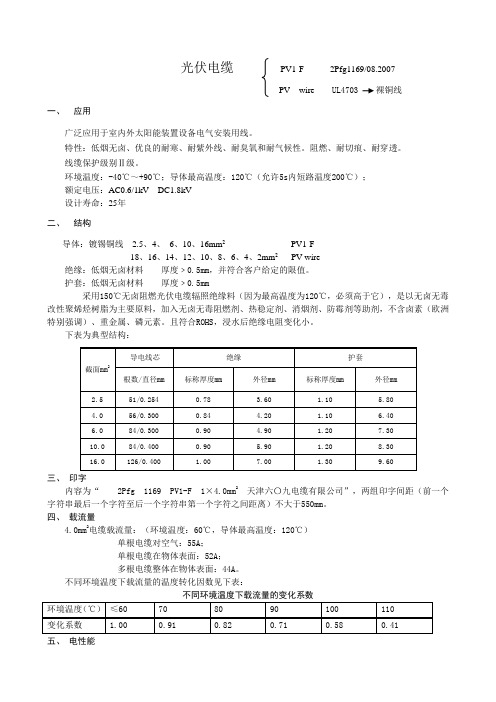
一、应用广泛应用于室内外太阳能装置设备电气安装用线。
特性:低烟无卤、优良的耐寒、耐紫外线、耐臭氧和耐气候性。
阻燃、耐切痕、耐穿透。
线缆保护级别Ⅱ级。
环境温度:-40℃~+90℃;导体最高温度:120℃(允许5s内短路温度200℃);额定电压:AC0.6/1kV DC1.8kV设计寿命:25年二、结构导体:镀锡铜线 2.5、4、6、10、16mm2PV1-F18、16、14、12、10、8、6、4、2mm2PV wire绝缘:低烟无卤材料厚度﹥0.5mm,并符合客户给定的限值。
护套:低烟无卤材料厚度﹥0.5mm采用150℃无卤阻燃光伏电缆辐照绝缘料(因为最高温度为120℃,必须高于它),是以无卤无毒改性聚烯烃树脂为主要原料,加入无卤无毒阻燃剂、热稳定剂、消烟剂、防霉剂等助剂,不含卤素(欧洲特别强调)、重金属、磷元素。
且符合ROHS,浸水后绝缘电阻变化小。
下表为典型结构:三、印字内容为“ 2Pfg 1169 PV1-F 1³4.0mm2天津六〇九电缆有限公司”,两组印字间距(前一个字符串最后一个字符至后一个字符串第一个字符之间距离)不大于550mm。
四、载流量4.0mm2电缆载流量:(环境温度:60℃,导体最高温度:120℃)单根电缆对空气:55A;单根电缆在物体表面:52A;多根电缆整体在物体表面:44A。
不同环境温度下载流量的温度转化因数见下表:不同环境温度下载流量的变化系数五、电性能1. 直流电阻成品电缆20℃时导电线芯直流电阻不大于5.09Ω/km。
2 浸水电压试验成品电缆(20m)在(20±5)℃水中浸入时间1h后经5min电压试验(交流6.5kV或直流15kV)不击穿。
3 长期耐直流电压样品长5m,放入(85±2)℃的含3%氯化钠(NaCl)的蒸馏水中(240±2)h,两端露出水面30cm。
线芯与水间加直流0.9kV电压(导电线芯接正极,水接负极)。
光伏线缆参数对比表格

光伏线缆不同标准下的参数对比图国家中国德国德国机构北京鉴衡认证中心TUV南德意志集团TUV南德意志集团执行标准NB/T42073-2016中华人民共和国能源行业标准ICS29.060.20K13备案号:55682-2016国家能源局2016-06-08发布2016-10-01实施2PFG1169/2007-08AK411.2.3,2008-02-21VDE-AR-E2283-4:2011EN50168:2014EN50618(DOP)为2015.10.27,DOW为2017.10.27,也就是说2017年10月27日后,所有进入到欧盟范围内得光伏线缆都要符合此标准的要求,此前使用其它标准的认证将不再适用额定电压1500V(导体间或导体对地),直流下最大允许电压为1.8KV900V(导体和地之间)1500V(导体和地之间)载流量GB/T3956-2008电缆的导体载流能力定义了标称导体截面积从1.5mm²到35mm²的载流能力定义了标称导体截面积从1.5mm²到240mm²的载流能力型号代码PV YJYJ PV1-F H1Z2Z2-K绝缘厚度绝缘厚度的平均值应不小于标称值,其最薄厚度应不小于标称值的90%-1mm。
不同标称导体截面积统一要求为:≥.5mm²⁴²不同标称导体截面积对应不同厚度要求护套厚度护套厚度的平均值应不小于标称值,其最薄厚度应不小于标称值的85%-1mm不同标称导体截面积统一要求为:≥.5mm不同标称导体截面积对应不同厚度要求绝缘电阻测量20℃的绝缘电阻应按GB/T3048.5-2007进行实验,实验条件见表3中的规定,绝缘电阻应符合表1和表2的规定。
不同标称导体截面积统一要求为:20℃时≥10²⁴Ω.cm;90℃时≥10¹¹Ω.cm。
不同标称导体截面积对应不同最小绝缘电阻要求90℃的绝缘电阻应按GB/T3048.5-2007进行实验,实验条件见表3中的规定,绝缘电阻应符合表1和表2的规定。
光伏电缆标准pfg1169
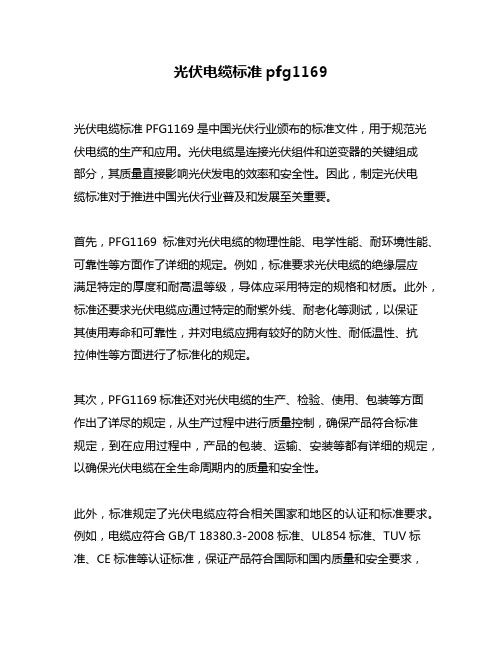
光伏电缆标准pfg1169光伏电缆标准PFG1169是中国光伏行业颁布的标准文件,用于规范光伏电缆的生产和应用。
光伏电缆是连接光伏组件和逆变器的关键组成部分,其质量直接影响光伏发电的效率和安全性。
因此,制定光伏电缆标准对于推进中国光伏行业普及和发展至关重要。
首先,PFG1169标准对光伏电缆的物理性能、电学性能、耐环境性能、可靠性等方面作了详细的规定。
例如,标准要求光伏电缆的绝缘层应满足特定的厚度和耐高温等级,导体应采用特定的规格和材质。
此外,标准还要求光伏电缆应通过特定的耐紫外线、耐老化等测试,以保证其使用寿命和可靠性,并对电缆应拥有较好的防火性、耐低温性、抗拉伸性等方面进行了标准化的规定。
其次,PFG1169标准还对光伏电缆的生产、检验、使用、包装等方面作出了详尽的规定,从生产过程中进行质量控制,确保产品符合标准规定,到在应用过程中,产品的包装、运输、安装等都有详细的规定,以确保光伏电缆在全生命周期内的质量和安全性。
此外,标准规定了光伏电缆应符合相关国家和地区的认证和标准要求。
例如,电缆应符合GB/T 18380.3-2008标准、UL854标准、TUV标准、CE标准等认证标准,保证产品符合国际和国内质量和安全要求,这有利于中国光伏电缆打入国际市场,进一步推进中国光伏行业的发展。
总之,光伏电缆标准PFG1169是推进中国光伏产业发展的重要文件。
通过对光伏电缆的物理性能、电学性能、耐环境性能、可靠性等方面的规范,保证了光伏电缆的质量和可靠性。
同时,通过对光伏电缆的生产、检验、使用、包装等方面的规定,进一步确保了光伏电缆在使用生命周期内的质量和安全性,这有利于提升中国光伏电缆的竞争力和走向国际市场的能力。
- 1、下载文档前请自行甄别文档内容的完整性,平台不提供额外的编辑、内容补充、找答案等附加服务。
- 2、"仅部分预览"的文档,不可在线预览部分如存在完整性等问题,可反馈申请退款(可完整预览的文档不适用该条件!)。
- 3、如文档侵犯您的权益,请联系客服反馈,我们会尽快为您处理(人工客服工作时间:9:00-18:30)。
2 Pfg 1169/08.2007 Requirements forcables for use in photovoltaic-systemsContentsSeite Foreword (3)1Scope (3)2Normative references (3)3Terms and definitions (5)4Halogen-free PV-cable (6)4.1Code designation (6)4.2Characteristics (6)4.3Construction (6)4.4Test (8)4.5Guideline for use (informative) (8)4.6Current carrying capacity (8)Annex A (normative) Test of mutual influence (15)Annex B (normative) Test of absence of halogen (16)Annex C (normative) Determination of halogens – Elemental test (17)Annex D (normative) Test of long term resistance of insulation to D.C (19)Annex E (normative) Cold impact test (20)Annex F (normative) Dynamic penetration test (21)Annex G (normative) Notch propagation (23)Figure 1 – Arrangement of marking (8)Figure F.1 – Arrangement for penetration test (22)Table 1 – Current carrying capacity of PV-cables (9)Table 2 – Conversion factor for deviating temperatures (9)Table 3 – Tests for halogen free PV-cable (10)Table 4 – Requirements for halogen free insulation and sheath compounds (13)Table A.1 – Requirements (15)Table B.1 – Test method, measurement, requirements (16)Table B.2 – Test sequence (16)Table E.1 – Parameter for cold impact test (20)ForewordThis test specification contents the requirements listed in a manuscript of the working group AK 411.2.3 …Leitungen für PV-Systeme“ of the German committee for standardization (DKE). This manuscript is intended to be published as German pre-standard. Up to the date of publishing of the pre-standard this test-specification of TUV Rheinland will be used for test and assessment of cables for use in PV-systems (PV-cables).1 Scope2 PfG 1169/08.2007 applies to flexible single-core cables (cords) for use at the DC-side of photovoltaic-systems with a maximum permissible voltage of DC 1,8 kV (conductor/conductor, non earthed system). The cables are suitable for use in safety class II.It is permitted to connect these cables as multiple-construction.The cables are intended to operate at ambient temperature until 90°C2 Normative referencesThe following referenced documents are indispensable for the application of this document. For dated references, only the edition cited applies. For undated references, the latest edition of the referenced document (including any amendments) applies.IEC 60364-5-52, Erection of low voltage installations –Part 5: Selection and erection of electrical equipment –Chapter 52: Wiring systemsEN 50267-2-1, Common test methods for cables under fire conditions – Tests on gases evolved during combustion of materials from cables – Part 2-1: Procedures – Determination of the amount of halogen acid gas;EN 50267-2-2, Common test methods for cables under fire conditions – Tests on gases evolved during combustion of materials from cables – Part 2-2: Procedures – Determination of degree of acidity of gases for materials by measuring pH and conductivity;EN 50305, Railway applications – Railway rolling stock cables having special fire performance – Test methodsEN 50395, Electrical test methods for low voltage energy cables;EN 50396, Electrical test methods for low voltage energy cables;EN 60068-2-78, Environmental testing - Part 2-78: Tests -Test Cab: Damp heat, steady state (IEC 60068-2-78)EN 60216-1, Electrical insulating materials - Properties of thermal endurance - Part 1: Ageing procedures and evaluation of test results (IEC 60216-1);EN 60216-2, Electrical insulating materials – Thermal endurance properties – Part 2: Determination of thermal endurance properties of electrical insulating materials – Choice of test criteria (IEC 60216-2);EN 60228, Conductor of insulated cables (IEC 60228)EN 60332-1-2, Tests on electric and optical fibre cables under fire conditions – Part 1-2: Test for vertical flame propagation for a single insulated wire or cable – Procedure for 1 kW pre-mixed flame; (IEC 60332-1-2)EN 60684-2, Flexible insulating sleeving – Part 2: Methods of test (IEC 60684-2)EN 60811-1-1, Insulating and sheathing materials of electric cables – Common test methods Part 1-1: General application – Measurement of thickness and overall dimensions – Test for determining the mechanical properties (IEC 60811-1-1)EN 60811-1-2, Insulating and sheathing materials of electric and optical cables – Common test methods. Part 1-2: General application. Thermal ageing methods (IEC 60811-1-2)EN 60811-1-3, Insulating and sheathing material of electric and optical cables – Common test methods – Part 1-3: General application – Methods for determining the density – Water absorption tests – Shrinkage test (IEC 60811-1-3)EN 60811-1-4, Insulating and sheathing materials of electric and optical cables – Common test methods. Part 1-4: General application. Tests at low temperature. (IEC 60811-1-4)EN 60811-2-1, Insulating and sheathing materials of electric and optical cables – Common test methods – Part 2-1: Methods specific to elastomeric compounds – Ozone resistance, hot set and mineral oil immersion tests (IEC 60811-2-1)EN 60811-3-1, Insulating and sheathing materials of electric cables – Common test methods Part 3-1: Methods specific to PVC compounds – Pressure test at high temperature, test for resistance to cracking (IEC 60811-3-1)HD 22.13, Rubber insulated cables of rated voltages up to and including 450/750 V Part 13: Single and multicore flexible cables, insulated and sheathed with crosslinked polymer and having low emission of smoke and corrosive gases;HD 605, Power cables – Part 605: Additional test methodsHD 60364-7-712Electrical installations of buildings – Part 7-712: Requirements for special installations or locations – Solar photovoltaic (PV) power supply systems (IEC 60364-7-712, modified)3 Terms and definitionsFor the purposes of this document, following definitions apply.3.1 Terms for test procedure3.1.1Type test (symbol T)Tests required to be made before supplying a type of cable covered by this standard on a general commercial basis, in order to demonstrate satisfactory performance characteristics to meet the intended application. These tests are of such a nature that, after they have been made, they need not be repeated, unless changes are made in the cable materials or design or manufacturing process which might change the performance characteristics.3.1.2sample tests (symbol S)Tests made on samples of completed cable or components taken from a completed cable, at a specified frequency, so as to verify that the finished product meets the specified requirements.3.1.3Routine tests (symbol R)Tests made by the manufacturer on each manufactured length of cable to check that each length meets the specified requirements3.2Rated voltageThe rated voltage of the cable determines the construction and the tests of the cable with regard to the electrical properties.The rated voltage is designated by two values of frequency voltage: U0/U in VoltU0 rated power frequency voltage between conductor and earth (metallic screen of cable or ambient medium);U rated power frequency voltage between two conductors of a multipole cable or of a system of single core cables.The rated voltage of the cable for a given application shall be suitable for the operating conditions in the system in which the cable is used.This requirement is applicable for both U o and UThe rated voltage between two conductors in a DC-system shall not exceed the 1,5 time value of rated voltage U of the cable, and the rated voltage between conductor and earth shall not exceed the 1,5 time value of rated voltage U o of the cable.NOTE The operating voltage of a system may exceed is rated voltage permanent for 20%. A cable may be operated with a voltage which value is 20% higher than rated voltage under condition that the rated voltage is not less than the rated voltage of the system.3.3DC sidepart of a PV installation from a PV cell to the DC terminals of the PV inverter3.4open-circuit voltage under standard test conditions U OC STCvoltage under standard test conditions across an unloaded (open) PV module, PV string, PV array, PV generator or on the DC side of the PV inverter3.5short-circuit current under standard test conditions I SC TCshort-circuit current of a PV module, PV string, PV array or PV generator under standard test conditions4 Halogen free PV-cable4.1 Code designationPV1-F4.2 Characteristics4.2.1Rated voltageAC U 0/U 0,6/1 kVDC 1,8 kV (conductor-conductor, non earthed system, circuit not under load).If the cable is used in DC-systems the rated voltage between two conductors shall not exceed the 1,5 time value of rated voltage U of the cable. In with single-phase earthed DC-systems this value shall be multiplied with factor 0,5. 4.2.2Temperature rangeAmbient temperature:–40 °C to +90 °C Max. temperature at conductor:120 °CThe cables are intended to operate at ambient temperature until 90°C. For this a temperature index of120°C applies to the insulation and the sheath, bas ed on EN 60216-1 (20.000h, 50% residual elongation). NoteThe expected period of use is 25 years.The permitted short-circuit-temperature refer to a period of 5s is 200°C.4.3 Construction4.3.1Conductor Number of conductors: 1The conductor shall be class 5, according to EN 60228. The single wires must be tinned. Preferred diameters: 2,5, 4, 6, 10, 16 mm 24.3.2Separation layerA separation layer of a suitable halogen free material may be applied around the conductor.额定电压导体工作温度导体绝缘4.3.3 InsulationThe insulation shall be a suitable halogen free material applied around the conductor.The insulation shall be extruded and shall consist of one or several adjacent adherent layers. It shall be solid and homogeneous, it must be possible to remove it without damage to the insulation itself, to the conductor and to the tin coating.The insulation shall be smooth, consistently applied and largely circular. Compliance shall be checked by inspection and by manual test.The wall thickness of insulation is specified by the manufacturer, but it must not fall short of the minimum value of 0,5mm.4.3.4 Separation layerA separation layer of a suitable halogen free material may be applied around the insulation.4.3.5 SheathThe core must be covered by a sheath.The sheath around the core must be of a suitable halogen free material.The sheath shall be extruded and shall consist of one or several adjacent adherent layers. The sheath shall be smooth and consistently applied.The wall thickness of sheath is specified by the manufacturer, but it must not fall short of the minimum value of 0,5mm.4.3.6 Outer diameterThe average value of the outer diameter shall be within the limits specified by the manufacturer.4.3.7 Multiple constructionEach single-core cable in a multiple construction shall pass the requirements of this document. Each additional component in a multiple construction shall pass the requirements of this document.4.3.8 Marking4.3.8.1 GeneralThe cable shall be marked as follows:a) Trademark;b) Code designation;c) Rated diameter.Marking may be by printing or by reproduction in relief on or in the sheath.4.3.8.2 TrademarkCables shall be provided with an indication of the manufacturer, which consist of a consecutively marking with company name or company sign or with (if trademarked) an identification number.4.3.8.3 Code designationCables shall be provided with an code designation according to 4.1 applied consecutively on sheath.4.3.8.4 Arrangement of markingEach marking is considered as consecutive if the spacing between the end of a marking and the begin of the following identical marking does not exceed following value:– 550mm, for marking on sheath or outer jacket.Following figure shows an example of marking on sheath.Figure 1 – Arrangement of marking4.3.8.5 DurabilityPrinted markings shall be durable. Compliance with this requirement shall be checked by the test given in 5.1 of EN 50396.4.3.8.6 LegibilityEach marking shall be legible.4.4 TestCompliance with the requirements of 4.3 shall be checked by visual inspection and tests according to table3.4.5 Guideline for use (informative)Cables according to this standard are intended for use in PV-systems according to EN 60364-7-712.4.6 Current carrying capacityAmbient temperature: 60°CMax. temperature at conductor: 120 °CTable 1 – Current carrying capacity of PV-cablesKind of installationRated diameter Single cable free inair Single cable onsurfacesTo cables adjacent onsurfacesmm2 A A A1,5 30 29 242,5 41 39 334 55 52 446 70 67 5710 98 93 7916 132 125 10725 176 167 14235 218 207 176Table 2 – Conversion factor for deviating temperaturesAmbient temperature Conversion factor°CUp to 60 1,0070 0,9180 0,8290 0,71100 0,58110 0,41Reduction factor for accumulation according to IEC 60364-5-52, Table B.52-17Table 3 – Tests for halogen free PV-cableNo. Test Requirementsof test standard clause5 Resistance against acid and alkalinesolutionT EN 60811-2-1 10 5.1Chemical stressacid: N-Oxal-acidalkaline solution: N-sodium hydroxide solutiontemperature °C 23duration h 1685.2Tensile strength:variation, max. % ± 305.3Elongation at break, min. % 1006 Test of influence T Annex A7 Cold impact test at –40 °C T Annex E8 Cold bending testDiameter of cable < 12,5 mmT EN 60811-1-4 8.2 8.1 Test conditions:– temperature °C –40 ± 2– duration of conditioning h 16 EN 60811-1-4 8.2.3 8.2 Results to be obtained Absence ofcracks9 Cold elongation testDiameter of cable ≥ 12,5 mmTable 3 10 Ozone resistance at complete cable T10.1 Method B EN 50396 8.1.3– temperature °C 40 ± 2– relative humidity % 55 ± 5– duration h 72– Ozone concentration %(by volume)(200 ± 50) × 10–610.2 Results to be obtained Absence ofcracks.11 Weathering/UV-resistance T HD 605/A1 2.4.20 11.1 Conditions:– duration h 720– temperature °C(Black-Standard-temperature)63– relative humidity % 65– min. power at W/m2wavelength 300 nm to 400 nm60 ± 2– duration spraying/drying min 18/102Results to be obtained Absence ofcracks.12 Dynamic penetration test T Annex F13 Notch propagation T Annex GNo. Test Requirementsof test standard clause14 Shrinkage test at complete cable T EN 60811-1-3 11((sheath)) 14.1 Conditions:– temperature °C 120– duration h 1– Distance L of sample mm 30014.2 Results to be obtained:– Maximum shrinkage. % 215 Test under fire conditions15.1 Test for vertical flame propagation at completecableT, S EN 60332-1-215.2 Assessment of halogen T, S15.2.1 Absence of halogen Annex B 15.2.2 Determination of halogens – Annex CTable 4 – Requirements for halogen free insulation and sheath compounds1 2 3 4 5 6 7Test method described in Type of compoundRef. No. Test Unitstandard clause insulation sheath1 Mechanical characteristics1.1 Properties before ageing EN 60811-1-1 9.21.1.1 Values to be obtained for the tensile strength:– median, min. N/mm26,5 8,01.1.2 Values to be obtained for the elongation atbreak:– median, min. % 125 125 1.2 Properties after ageing in oven EN 60811-1-2 8.11.2.1 Ageing conditions:– temperature °C 150 ± 2 150 ± 2 – duration of treatment h 7 × 24 7 × 24 1.2.2 Values to be obtained for the tensile strength:c– median, min. N/mm2– – – variation, max. % –30a–30a1.2.3 Values to be obtained for the elongation atbreak:c– median, min. % – – – variation, max. % – 30a– 30a 1.3 Hot set test d EN 60811-2-1 91.3.1 Conditions– Temperature °C 200± 3 200± 3 – Time under load min 15 15 – mechanical stress N/cm220 20 1.3.2 Values to be obtained– elongation under load, max. % 100 100 – permanent elongation after cooling, max. % 25 25 1.4 Thermal endurance properties EN 60216-21.4.1 ConditionsEither test of elongation at break or bending testshall be performed.– Temperature index 120 120 – elongation at break c% 50 50 – bending test EN 50305 7.2 2 D 2 D 1.5 Cold elongation test EN 60811-1-4 8.41.5.1 Conditions:– temperature °C –40 ± 2 –40 ± 2 – duration h EN 60811-1-4 8.4.4 und 8.4.5 b b 1.5.2 Values to be obtained:– elongation at break, min. % 30 301 2 3 4 5 6 7Test method described in Type of compoundRef. No. Test Unitstandard clause insulation sheatha No positive value for variation fixed.b See test method in column 4 and 5.c This test shall be performed at test samples of insulation and sheath compound.d This test shall be performed only at cross-linked insulation and sheath compoundTest of mutual influenceA.1 ConditionsTest samples must be aged for 7 days at (135 ± 2) °C at conditions according to table 2A.2 RequirementsAfter ageing the insulation and the sheath shall pass the requirements of table A.1.Table A.1 – RequirementsTests units insulation sheathTensile strength – median, min. N/mm2– –– variation a, max. % ± 30 –30 b Elongation at break – median, min. % – –– variation a, max. % ± 30 ± 30a Variation: difference between the median value obtained after ageing and the median value obtained without ageing expressed as apercentage of the latter.b Positive tolerances are not limited.Test of absence of halogenB.1 Requirements of extruded materialsInsulation and sheath shall pass the requirements as follows: a) Type testThe material must be tested as described in table B.1.Table B.1 – Test method, measurement, requirementsTest methodMeasurementrequirements1 EN 50267-2-2 pH and conductivity pH ≥ 4,3 undconductivity ≤ 10 µS/mm a 2 EN 50267-2-1 Chlorine- and Bromine content, expressed in HCI ≤ 0,5 %3aAnnex CHalogen: FluorideIf negative the test should be finished. No further test is necessary.The material shall be accepted.If positive, test of 3b shall be performed 3bEN 60684-2Fluoride content≤ 0,1 %a If discrepancies regarding conductivity appear, e.g. the recommended value is exceeded even if there is compliance with therecommended ph-value, other test method may be applied after agreement with all participants.b) Selection testThe material shall be tested according to test sequence of table B.2.Table B.2 – Test sequenceTest method MeasurementValue ResultIf negative the test should be finished. No further test is necessary.The material shall be accepted. Phase 0 HD 22.13,Annex CHalogen: Fluoride, Chloride and BromideIf positive continue with phase 1.< 4,3 The material shall be revised. pH ≥ 4,3Conductivity shall be tested. conductivity ≤ 2,5 µS/mmThe material shall be accepted. No further test is necessary.conductivity > 10 µS/mm The material shall be revised.Phase 1 EN 50267-2-2 conductivity (s)> 2,5 µS/mm but ≤ 10 µS/mm Test according to EN 50267-2-1 shall be performed > 0,5 % The material shall be revised.Phase 2 EN 50267-2-1Chlorine- and Bromine content, expressed in HCI≤ 0,5 % Test according to EN 60684-2 shall be performed. > 0,1 % The material shall be revised. Phase 3 EN 60684-2Fluoride content≤ 0,1 %The material shall be accepted.Determination of halogens – Elemental testWarningOwing to its potentially hazardous nature, the fusion operation should be carried out in a fume cupboard, using a safety screen.C.1 EquipmentBunsen burner3 small/medium soda glass test tubes (approximately 50 mm x 10 mm)Test tube holderEvaporating basin/mortarWire gauze;FunnelFilter paperC.2 MaterialsUnknown sampleSodium metalDilute nitric acid (5 %)Aqueous silver nitrate (5 %)Dilute ammonia (10 %)Freshly made up zirconium-alizarin red S reagentGlacial acetic acidAcid/pH indicator papersC.3 ProcedureC.3.1 Sodium fusionPlace 200 mg – 250 mg of the sample into the bottom of a small soda glass test tube. Add 10 ml of distilled/de-ionized water to the evaporating basin and place this in the fume cupboard behind the safety screen. Whilst holding the test tube firmly with the test tube holder at an angle of 45° - 60° to the vertical, introduce a piece of freshly cut, clean sodium (about the size of a small pea) (200 mg – 250 mg) into the mouth of the test tube without allowing it to come into contact with the sample. With the safety screen in place, heat the sodium gently until it melts and runs down on to the sample (there may be a vigorous reaction when the molten sodium reaches the sample if halogens are present). Heat the tube gently for about 1 min, then more strongly until the lower 20 mm of the tube glows red hot. Plunge the red hot tube into the water in the evaporating basin, immediately placing the gauze on top. (The gauze prevents any loss of material when the tube shatters on contact with the water.) Allow any non reacted sodium to react before grinding up the solution and glass. Filter, and separate the filtrate into two equal portions.C.3.2 Chlorine and bromineTo the first portion of the filtrate, add sufficient nitric acid to make the solution acidic. Boil this solution until its total volume has been reduced by half (this is to remove any HCN or H2S, if present, which would interfere with the test). Add 1 ml silver nitrate solution; a white or yellowish-white precipitate indicates the presence of halogen (Cl, Br) in the original sample. (If the liquor is decanted, and the precipitate is white and readily soluble in dilute ammonia, then chloride is present.)C.3.3 FluorineTo the second portion of the filtrate, acidify with glacial acetic acid. Boil this solution until its total volume has been reduced by half. Add 2 to 3 drops freshly prepared zirconium lake reagent (equal volumes of: a) Alizarin solution: 0,05 g Alizarin Red-S in 50 ml distilled water, b) Zirconium solution: 0,05 g zirconium nitrate in 10 ml concentrated HCl diluted with 50 ml distilled water). Heat at 40 °C for 1 h. The presence of fluoride is indicated by the red/pink colouration being bleached to yellow.Test of long term resistance of insulation to D.C.A test sample with a length of minimum 5m shall be immersed into water containing 3 % NaCl. Further on minimum 300mm of the sample shall stick out of the water. The water-bath shall be retained for (240 ± 2) h at a high temperature of (85 ± 2) °C and a D.C.-vol tage 0,9kV shall be applied between conductor and water whereby the conductor shall be connected to the positive potential.The current of this circuit shall be measured with a period of not more than 24h. If possible a continuous measurement shall be preferred.The measured values shall be recorded in a time-current-curve which identifies a stable progress.NOTE A stable progress is e.g. an increase of less than 10% of leakage current on the average for a time of 24h (This is part of the inspection based on practical experiences)After storing the samples shall be taken out of the salt-water-solution and a voltage test according to Ref.-No. 1.2 of table 1 shall be performed. The test voltage shall be the rated voltage (U) of the cable.Cold impact testThe cold impact test shall be performed at –40°C ac cording to clause 8.5 of EN 60811-1-4, but the mass of hammer, the mass of test probe and the height shall comply with table 2.Table E.1 – Parameter for cold impact testDiameter of cable (D) Mass of hammer Mass of test probe height mm g g mmD < 15 1 000 200 10015 < D≤ 25 1 500 200 150D > 25 2 000 200 200The inner and outer surface of sheath shall be inspected with normal or corrective visual faculty without magnification. Only the outer surface of the insulation shall be inspected. No cracks must be determinedAnnex F(normative)Dynamic penetration testA test apparatus for pull test (or a equivalent apparatus) shall be operated in pressure modus and shall be equipped with a measuring device which is able to record the force of penetration of the spring-steel-needle (see figure F.1b) through the insulation or sheath of a completed cable. A circuit with low voltage which finish the test at the moment when the needle penetrates the insulation or the sheath and makes contact with the conductor shall be added.The test shall be performed at room temperature. The force applying to the needle shall be increased continuously with 1 N/s until contact with the conductor has been made. 4 tests at each sample shall be performed and the force at the moment of contact shall be recorded. After each test the sample shall be moved forward and shall be turned clockwise for 90°.The mean value of the 4 test results must not be less than the minimum value F determined with following formulaF = 50 ⋅DD diameter of cable in mmDimensions in mma) detail X(edges not broken or rounded, without ridge)b) detail YCaption 1 N.A. 2 N.A. 3 Load 4 Clamp 5 Sample6Mounting surface7 Fixing screw 8 Blade9 Shoulder with sufficient depth for testing the insulation 10 Needle of spring steel 11SampleFigure F.1 – Arrangement for penetration testAnnex G(normative)Notch propagationThree samples of the cable shall be notched, to a depth of 0,05 mm of the insulation or sheathing, at four points equally spaced with respect to one another around the circumference and 25 mm apart along the length, and in a plane mutually perpendicular to the conductor.One of the samples shall be conditioned at -15 °C, one at ambient temperature and one at 85 °C, in all cases for 3 h, after which time they shall be wound on to a mandrel, (3 ± 0,3) times the minimum specified diameter of the cable, whilst at the conditioning temperature. The notched sample shall be wrapped around the mandrel such that at least one notch is on the outside of the cable.The sample shall be allowed to return to ambient temperature and then subjected to the voltage test given in no. 1.2 of Table 1 but at half the rated voltage U0.。
